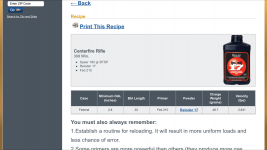35 Whelen
Handloader
- Dec 22, 2011
- 2,274
- 683
L&L here is a part of a story I just was reading by Nat Foster on Terminal Ballistics site, kinda interesting on the .308 with heavy bullets thought you may be interested , this does not pertain to a 200gr but this is what he had to say about it. Quote:
"The 220 grain Sierra bullet, is not well suited to .308 velocities, not due to its bullet design or construction but more because of potential muzzle velocities. The 220 grain round nose excels in killing performance when driven at velocities of around and a little above 2400fps. The .308 can only drive this bullet weight at 2150fps and problems such as over expansion (failure to reduce frontal area) due to loss of velocity during penetration, tend to produce counterproductive results. :wink:
Just a note about heavy bullets in the 308 from watching hunters shoot animals over the last 40 years as a guide............... On DEER, so this doesn't apply to Moose, Elk or Bear, I have seen a lot of Deer shot with the 180gr bullet, and like any caliber and any bullet weight; if they are hit correctly about anything will do it, But for my money, unless they are shoulder shot,with a 180gr or end for ended. I would say that a 150gr bullet; on DEER; was considerably better combo when the deer isn't shot right where it should be , a lot of times the 180gr bullets going around 2500fps when they hit a deer don't seam to open up well, and just punch smallish holes thru em, of course hit right in the shoulder it would flatten them. The 150s on the other hand because of extra velocity seams to always expand correctly and I found them to work nicely. Just a thought...........
"The 220 grain Sierra bullet, is not well suited to .308 velocities, not due to its bullet design or construction but more because of potential muzzle velocities. The 220 grain round nose excels in killing performance when driven at velocities of around and a little above 2400fps. The .308 can only drive this bullet weight at 2150fps and problems such as over expansion (failure to reduce frontal area) due to loss of velocity during penetration, tend to produce counterproductive results. :wink:
Just a note about heavy bullets in the 308 from watching hunters shoot animals over the last 40 years as a guide............... On DEER, so this doesn't apply to Moose, Elk or Bear, I have seen a lot of Deer shot with the 180gr bullet, and like any caliber and any bullet weight; if they are hit correctly about anything will do it, But for my money, unless they are shoulder shot,with a 180gr or end for ended. I would say that a 150gr bullet; on DEER; was considerably better combo when the deer isn't shot right where it should be , a lot of times the 180gr bullets going around 2500fps when they hit a deer don't seam to open up well, and just punch smallish holes thru em, of course hit right in the shoulder it would flatten them. The 150s on the other hand because of extra velocity seams to always expand correctly and I found them to work nicely. Just a thought...........





